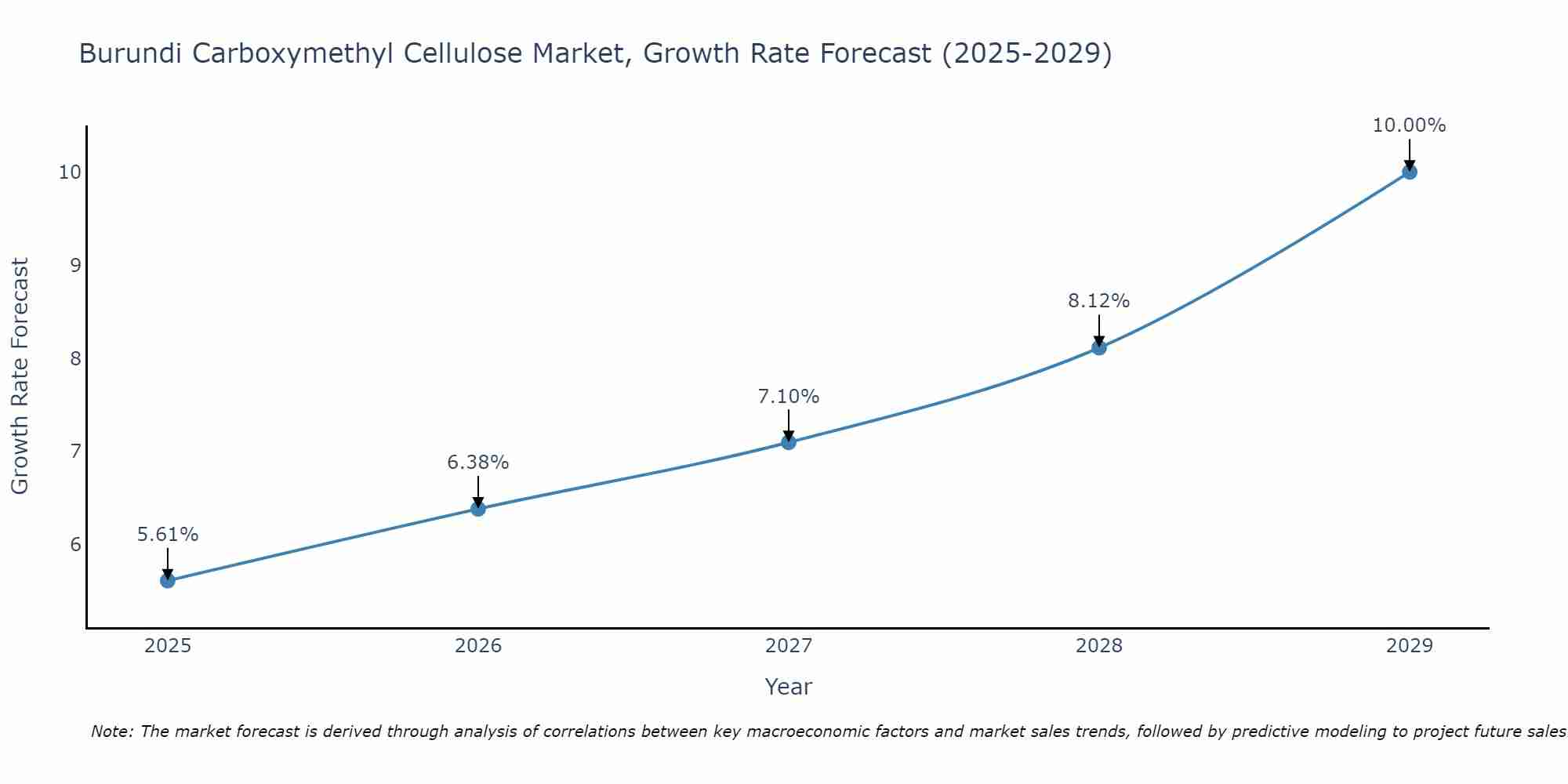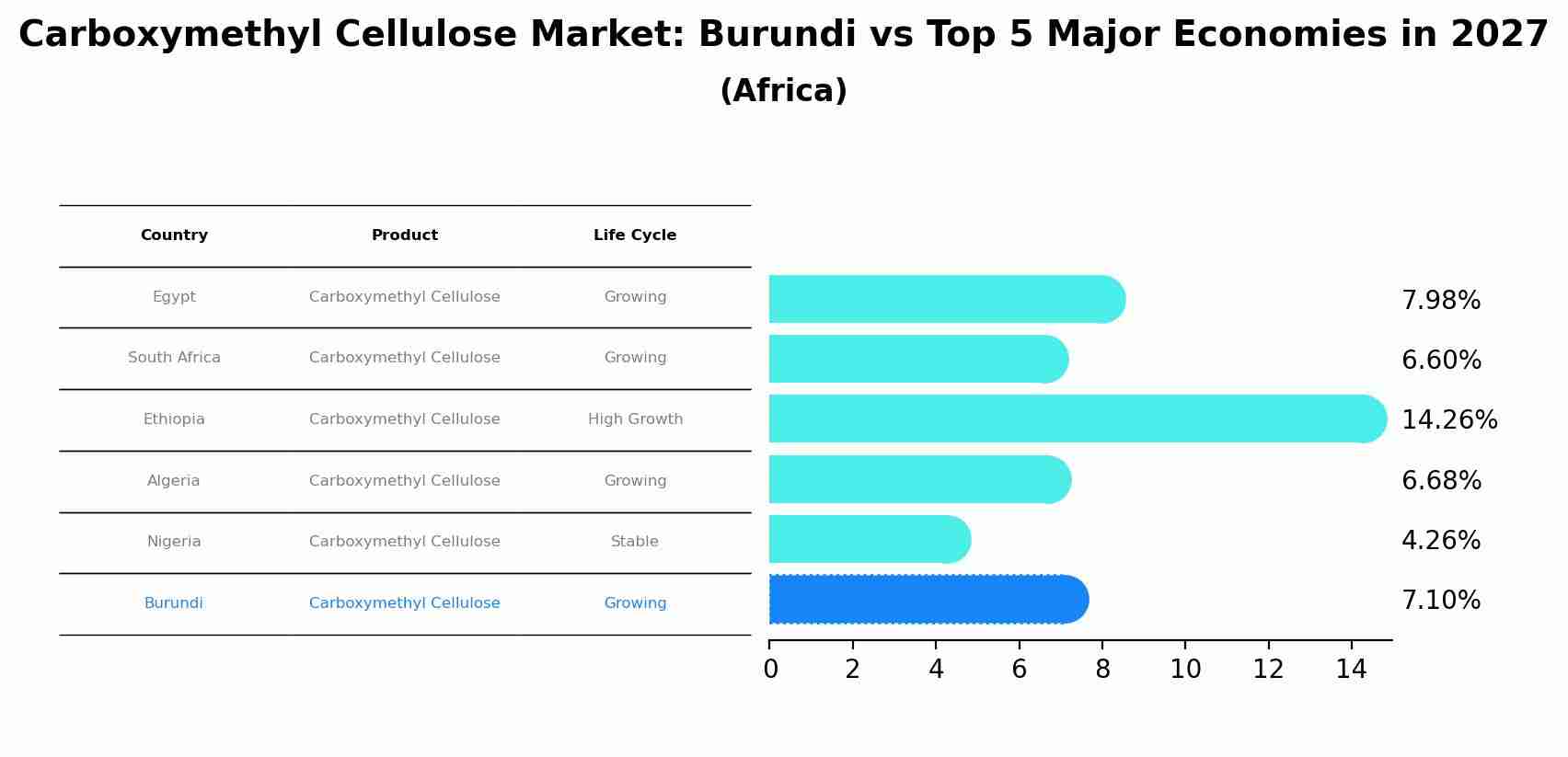Burundi Carboxymethyl Cellulose Market (2025-2031) | Revenue, Companies, Share, Segmentation, Trends, Industry, Forecast, Value, Outlook, Growth, Size & Analysis
| Product Code: ETC5254045 | Publication Date: Nov 2023 | Updated Date: Oct 2025 | Product Type: Market Research Report | |
| Publisher: 6Wresearch | Author: Bhawna Singh | No. of Pages: 60 | No. of Figures: 30 | No. of Tables: 5 |
Burundi Carboxymethyl Cellulose Market Size Growth Rate
The Burundi Carboxymethyl Cellulose Market is likely to experience consistent growth rate gains over the period 2025 to 2029. From 5.61% in 2025, the growth rate steadily ascends to 10.00% in 2029.

Carboxymethyl Cellulose Market: Burundi vs Top 5 Major Economies in 2027 (Africa)
By 2027, the Carboxymethyl Cellulose market in Burundi is anticipated to reach a growth rate of 7.10%, as part of an increasingly competitive Africa region, where Egypt remains at the forefront, supported by South Africa, Ethiopia, Algeria and Nigeria, driving innovations and market adoption across sectors.

Burundi Carboxymethyl Cellulose Market Overview
The carboxymethyl cellulose (CMC) market in Burundi is small but developing, driven by its use in various industries, including food and beverages, pharmaceuticals, and personal care. As these sectors grow, the demand for CMC, which acts as a thickener, stabilizer, and emulsifier, is expected to increase. The market is likely to benefit from rising awareness of the products versatility and its application in enhancing product quality.
Drivers of the market
The carboxymethyl cellulose (CMC) market in Burundi is driven by its diverse applications in industries such as food and beverages, pharmaceuticals, and cosmetics. CMC is used as a thickening agent, stabilizer, and emulsifier in various products. The growing demand for processed and packaged foods, along with the increasing use of CMC in pharmaceutical and personal care products, supports the market`s expansion. Additionally, the focus on improving product quality and functionality drives the demand for carboxymethyl cellulose.
Challenges of the market
The carboxymethyl cellulose market in Burundi is constrained by high import costs and limited local production. Carboxymethyl cellulose, used in various industries including food and pharmaceuticals, requires specialized processing that may not be locally available. The reliance on imports can result in higher prices and potential supply chain issues, affecting market growth.
Government Policy of the market
Carboxymethyl cellulose (CMC), a versatile compound used in food, pharmaceuticals, and industrial applications, is regulated by the Burundian government to ensure its safety and efficacy. Policies include standards for the production and quality control of CMC products to protect consumer health and ensure product performance. The government also promotes local production and research into CMC applications, aiming to support the growth of industries that rely on this compound. Environmental regulations are in place to manage the impact of CMC manufacturing processes and encourage sustainable practices.
Key Highlights of the Report:
- Burundi Carboxymethyl Cellulose Market Outlook
- Market Size of Burundi Carboxymethyl Cellulose Market, 2024
- Forecast of Burundi Carboxymethyl Cellulose Market, 2031
- Historical Data and Forecast of Burundi Carboxymethyl Cellulose Revenues & Volume for the Period 2021-2031
- Burundi Carboxymethyl Cellulose Market Trend Evolution
- Burundi Carboxymethyl Cellulose Market Drivers and Challenges
- Burundi Carboxymethyl Cellulose Price Trends
- Burundi Carboxymethyl Cellulose Porter`s Five Forces
- Burundi Carboxymethyl Cellulose Industry Life Cycle
- Historical Data and Forecast of Burundi Carboxymethyl Cellulose Market Revenues & Volume By Purity for the Period 2021-2031
- Historical Data and Forecast of Burundi Carboxymethyl Cellulose Market Revenues & Volume By Above 95% for the Period 2021-2031
- Historical Data and Forecast of Burundi Carboxymethyl Cellulose Market Revenues & Volume By 80% - 95% for the Period 2021-2031
- Historical Data and Forecast of Burundi Carboxymethyl Cellulose Market Revenues & Volume By Below 80% for the Period 2021-2031
- Historical Data and Forecast of Burundi Carboxymethyl Cellulose Market Revenues & Volume By End-user for the Period 2021-2031
- Historical Data and Forecast of Burundi Carboxymethyl Cellulose Market Revenues & Volume By Food & beverage for the Period 2021-2031
- Historical Data and Forecast of Burundi Carboxymethyl Cellulose Market Revenues & Volume By Pharmaceuticals for the Period 2021-2031
- Historical Data and Forecast of Burundi Carboxymethyl Cellulose Market Revenues & Volume By Personal care for the Period 2021-2031
- Historical Data and Forecast of Burundi Carboxymethyl Cellulose Market Revenues & Volume By Oil & gas for the Period 2021-2031
- Historical Data and Forecast of Burundi Carboxymethyl Cellulose Market Revenues & Volume By Pulp & paper for the Period 2021-2031
- Historical Data and Forecast of Burundi Carboxymethyl Cellulose Market Revenues & Volume By Detergents & laundry for the Period 2021-2031
- Historical Data and Forecast of Burundi Carboxymethyl Cellulose Market Revenues & Volume By Others for the Period 2021-2031
- Burundi Carboxymethyl Cellulose Import Export Trade Statistics
- Market Opportunity Assessment By Purity
- Market Opportunity Assessment By End-user
- Burundi Carboxymethyl Cellulose Top Companies Market Share
- Burundi Carboxymethyl Cellulose Competitive Benchmarking By Technical and Operational Parameters
- Burundi Carboxymethyl Cellulose Company Profiles
- Burundi Carboxymethyl Cellulose Key Strategic Recommendations
Frequently Asked Questions About the Market Study (FAQs):
1 Executive Summary |
2 Introduction |
2.1 Key Highlights of the Report |
2.2 Report Description |
2.3 Market Scope & Segmentation |
2.4 Research Methodology |
2.5 Assumptions |
3 Burundi Carboxymethyl Cellulose Market Overview |
3.1 Burundi Country Macro Economic Indicators |
3.2 Burundi Carboxymethyl Cellulose Market Revenues & Volume, 2021 & 2031F |
3.3 Burundi Carboxymethyl Cellulose Market - Industry Life Cycle |
3.4 Burundi Carboxymethyl Cellulose Market - Porter's Five Forces |
3.5 Burundi Carboxymethyl Cellulose Market Revenues & Volume Share, By Purity, 2021 & 2031F |
3.6 Burundi Carboxymethyl Cellulose Market Revenues & Volume Share, By End-user, 2021 & 2031F |
4 Burundi Carboxymethyl Cellulose Market Dynamics |
4.1 Impact Analysis |
4.2 Market Drivers |
4.2.1 Increasing demand for carboxymethyl cellulose in the food and beverage industry as a thickening agent and stabilizer. |
4.2.2 Growing awareness about the benefits of carboxymethyl cellulose in pharmaceutical applications. |
4.2.3 Expansion of the cosmetics and personal care industry, driving the demand for carboxymethyl cellulose as a binding agent. |
4.3 Market Restraints |
4.3.1 Fluctuating prices of raw materials used in the production of carboxymethyl cellulose. |
4.3.2 Stringent regulations related to the usage and approval of carboxymethyl cellulose in different industries. |
5 Burundi Carboxymethyl Cellulose Market Trends |
6 Burundi Carboxymethyl Cellulose Market Segmentations |
6.1 Burundi Carboxymethyl Cellulose Market, By Purity |
6.1.1 Overview and Analysis |
6.1.2 Burundi Carboxymethyl Cellulose Market Revenues & Volume, By Above 95%, 2021-2031F |
6.1.3 Burundi Carboxymethyl Cellulose Market Revenues & Volume, By 80% - 95%, 2021-2031F |
6.1.4 Burundi Carboxymethyl Cellulose Market Revenues & Volume, By Below 80%, 2021-2031F |
6.2 Burundi Carboxymethyl Cellulose Market, By End-user |
6.2.1 Overview and Analysis |
6.2.2 Burundi Carboxymethyl Cellulose Market Revenues & Volume, By Food & beverage, 2021-2031F |
6.2.3 Burundi Carboxymethyl Cellulose Market Revenues & Volume, By Pharmaceuticals, 2021-2031F |
6.2.4 Burundi Carboxymethyl Cellulose Market Revenues & Volume, By Personal care, 2021-2031F |
6.2.5 Burundi Carboxymethyl Cellulose Market Revenues & Volume, By Oil & gas, 2021-2031F |
6.2.6 Burundi Carboxymethyl Cellulose Market Revenues & Volume, By Pulp & paper, 2021-2031F |
6.2.7 Burundi Carboxymethyl Cellulose Market Revenues & Volume, By Detergents & laundry, 2021-2031F |
7 Burundi Carboxymethyl Cellulose Market Import-Export Trade Statistics |
7.1 Burundi Carboxymethyl Cellulose Market Export to Major Countries |
7.2 Burundi Carboxymethyl Cellulose Market Imports from Major Countries |
8 Burundi Carboxymethyl Cellulose Market Key Performance Indicators |
8.1 Research and development investment in new applications of carboxymethyl cellulose. |
8.2 Number of patents filed for innovative carboxymethyl cellulose formulations. |
8.3 Rate of adoption of carboxymethyl cellulose in emerging industries. |
9 Burundi Carboxymethyl Cellulose Market - Opportunity Assessment |
9.1 Burundi Carboxymethyl Cellulose Market Opportunity Assessment, By Purity, 2021 & 2031F |
9.2 Burundi Carboxymethyl Cellulose Market Opportunity Assessment, By End-user, 2021 & 2031F |
10 Burundi Carboxymethyl Cellulose Market - Competitive Landscape |
10.1 Burundi Carboxymethyl Cellulose Market Revenue Share, By Companies, 2024 |
10.2 Burundi Carboxymethyl Cellulose Market Competitive Benchmarking, By Operating and Technical Parameters |
11 Company Profiles |
12 Recommendations | 13 Disclaimer |
- Single User License$ 1,995
- Department License$ 2,400
- Site License$ 3,120
- Global License$ 3,795
Search
Thought Leadership and Analyst Meet
Our Clients
Related Reports
- Germany Breakfast Food Market (2026-2032) | Industry, Share, Growth, Size, Companies, Value, Analysis, Revenue, Trends, Forecast & Outlook
- Australia Briquette Market (2025-2031) | Growth, Size, Revenue, Forecast, Analysis, Trends, Value, Share, Industry & Companies
- Vietnam System Integrator Market (2025-2031) | Size, Companies, Analysis, Industry, Value, Forecast, Growth, Trends, Revenue & Share
- ASEAN and Thailand Brain Health Supplements Market (2025-2031) | Strategy, Consumer Insights, Analysis, Investment Trends, Opportunities, Growth, Size, Share, Industry, Revenue, Segments, Value, Segmentation, Supply, Forecast, Restraints, Outlook, Competition, Drivers, Trends, Demand, Pricing Analysis, Competitive, Strategic Insights, Companies, Challenges
- ASEAN Bearings Market (2025-2031) | Strategy, Consumer Insights, Analysis, Investment Trends, Opportunities, Growth, Size, Share, Industry, Revenue, Segments, Value, Segmentation, Supply, Forecast, Restraints, Outlook, Competition, Drivers, Trends, Demand, Pricing Analysis, Competitive, Strategic Insights, Companies, Challenges
- Europe Flooring Market (2025-2031) | Outlook, Share, Industry, Trends, Forecast, Companies, Revenue, Size, Analysis, Growth & Value
- Saudi Arabia Manlift Market (2025-2031) | Outlook, Size, Growth, Trends, Companies, Industry, Revenue, Value, Share, Forecast & Analysis
- Uganda Excavator, Crane, and Wheel Loaders Market (2025-2031) | Strategy, Consumer Insights, Analysis, Investment Trends, Opportunities, Growth, Size, Share, Industry, Revenue, Segments, Value, Segmentation, Supply, Forecast, Restraints, Outlook, Competition, Drivers, Trends, Demand, Pricing Analysis, Competitive, Strategic Insights, Companies, Challenges
- Rwanda Excavator, Crane, and Wheel Loaders Market (2025-2031) | Strategy, Consumer Insights, Analysis, Investment Trends, Opportunities, Growth, Size, Share, Industry, Revenue, Segments, Value, Segmentation, Supply, Forecast, Restraints, Outlook, Competition, Drivers, Trends, Demand, Pricing Analysis, Competitive, Strategic Insights, Companies, Challenges
- Kenya Excavator, Crane, and Wheel Loaders Market (2025-2031) | Strategy, Consumer Insights, Analysis, Investment Trends, Opportunities, Growth, Size, Share, Industry, Revenue, Segments, Value, Segmentation, Supply, Forecast, Restraints, Outlook, Competition, Drivers, Trends, Demand, Pricing Analysis, Competitive, Strategic Insights, Companies, Challenges
Industry Events and Analyst Meet
Whitepaper
- Middle East & Africa Commercial Security Market Click here to view more.
- Middle East & Africa Fire Safety Systems & Equipment Market Click here to view more.
- GCC Drone Market Click here to view more.
- Middle East Lighting Fixture Market Click here to view more.
- GCC Physical & Perimeter Security Market Click here to view more.
6WResearch In News
- Doha a strategic location for EV manufacturing hub: IPA Qatar
- Demand for luxury TVs surging in the GCC, says Samsung
- Empowering Growth: The Thriving Journey of Bangladesh’s Cable Industry
- Demand for luxury TVs surging in the GCC, says Samsung
- Video call with a traditional healer? Once unthinkable, it’s now common in South Africa
- Intelligent Buildings To Smooth GCC’s Path To Net Zero


















